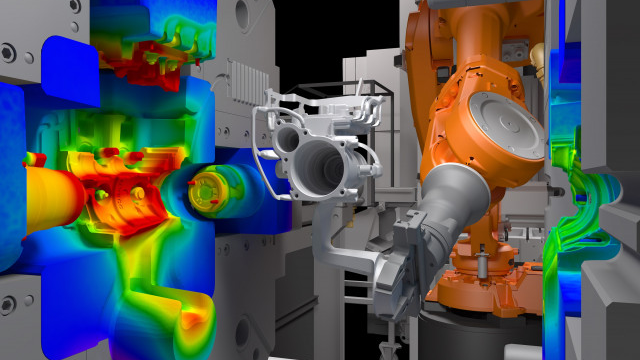How Foundry Simulation Software Helps All Manufacturers Benefit
2024-12-26 14:18:21 hits:0
With the rapid development of industrial technology, foundry simulation software has become an indispensable tool in modern foundry industries. Whether for large-scale manufacturing enterprises or small and medium-sized foundries, the use of foundry simulation software can significantly improve production efficiency, optimize casting quality, and reduce costs. This article will explain foundry simulation software from three aspects: first, what foundry simulation software is; second, the costs associated with using it; and third, the benefits it brings.

1. What is Foundry Simulation Software?
Foundry simulation software is a computer-aided tool used to simulate various physical phenomena in the casting process (such as metal flow, heat transfer, solidification, etc.), helping designers and manufacturers optimize casting processes. These software tools typically use mathematical models and physical principles to accurately predict potential issues that may arise during the casting process, allowing manufacturers to avoid costly trial and error.
The basic functions of foundry simulation software include:
- Thermal Flow Simulation: Predicting temperature variations in castings during the pouring process and identifying potential thermal stresses or cold shuts.
- Flow Analysis: Simulating the flow path of molten metal to help designers optimize gating systems and prevent defects like porosity and inclusions.
- Solidification Process Prediction: Analyzing the solidification process of castings to evaluate potential defects such as porosity and cracks.
- Stress Analysis: Detecting stress distributions in castings during the casting process to avoid deformations or cracking.
Through these simulation analyses, foundry simulation software provides manufacturers with data-driven insights, enabling them to detect and address potential problems during the design stage, thus avoiding unnecessary trials and revisions in actual production.
2. The Costs of Foundry Simulation Software
The costs associated with foundry simulation software vary depending on the software brand, functionality, and scale of use. Generally, the costs of using foundry simulation software can be broken down into the following categories:
Software Purchase Cost: There are various foundry simulation software available in the market, such as MAGMASOFT, ProCAST, FLOW-3D, and others. Prices differ significantly between brands and versions. For small businesses, the cost of a basic or standard version of simulation software might be several thousand to tens of thousands of dollars annually. For larger enterprises, advanced versions with additional modules can cost several tens of thousands or even more annually
Training and Implementation Costs: To maximize the benefits of the software, manufacturers typically need to provide training for their operators. These training costs are usually provided by the software supplier and can include online or on-site training. Training fees can range from a few hundred to several thousand dollars depending on the depth and duration of the course.
Maintenance and Update Costs: Foundry simulation software often requires regular updates and maintenance, which is an ongoing cost for enterprises. Maintenance and technical support fees are typically charged annually, and can range from a few hundred to several thousand dollars, depending on the complexity of the software and the services offered.
Hardware Support Costs: Foundry simulations require substantial computational power, meaning that high-performance computing systems and servers are needed. If the current hardware infrastructure is insufficient, businesses may need to invest in new hardware, which could cost from a few thousand to tens of thousands of dollars, depending on the computational needs.
Overall, the costs of foundry simulation software are mainly concentrated in initial investments and ongoing maintenance. However, compared to traditional physical testing and trial simulations, the software's usage cost is relatively manageable, and as production scales up, the economic benefits of the software become increasingly apparent.
3. The Benefits of Foundry Simulation Software
Despite the initial investment, the numerous benefits of using foundry simulation software become clear in the long run. These benefits include:
1. Improving Casting Quality
Foundry simulation software precisely simulates various aspects of the casting process, significantly reducing casting defects such as porosity, cold shuts, cracks, and others. By predicting temperature distribution, metal flow, and solidification processes, manufacturers can optimize their processes in a virtual environment before actual casting. This ensures consistent and stable product quality while minimizing the risk of defects during production.

2. Reducing Production Costs
Foundry simulation software reduces production costs by optimizing casting processes, reducing the need for trial runs, and minimizing scrap rates. By predicting and optimizing the gating system, mold design, and cooling channels, manufacturers can minimize material waste and improve process efficiency. Additionally, by detecting issues before production begins, manufacturers can avoid rework and scrap, thereby lowering overall production costs.

3. Shortening Product Development Time
Foundry simulation software provides a rapid validation tool for product designers. Traditional casting processes often require multiple trials and adjustments, but with simulation, manufacturers can identify and resolve problems during the design stage, significantly shortening the development cycle. This not only helps speed up time-to-market but also allows businesses to respond quickly to market demand, enhancing their competitiveness.

4. Optimizing Process Design
Foundry simulation software allows designers to evaluate and optimize different process options, ensuring that the best casting methods, pouring techniques, and mold structures are selected. By simulating different process parameters, manufacturers can avoid costly or ineffective process designs and streamline the production process. This ability to optimize the process virtually before actual production saves time, money, and resources.
5. Supporting Innovative Designs
As market demand for high-performance castings grows, product designs are becoming increasingly complex. Foundry simulation software enables the simulation of complex shapes and new materials, providing technical support for product innovation. Designers can test and validate innovative designs in a virtual environment to assess their castability and manufacturability, reducing the risks associated with new product development and encouraging more breakthrough designs.

6. Improving Production Flexibility
Foundry simulation software allows manufacturers to adapt quickly to varying production demands, particularly in industries with multiple products and small batch sizes. Simulation software can quickly simulate different casting specifications and shapes, helping manufacturers adjust their production processes without extensive retooling or machine downtime. This flexibility enhances the efficiency and agility of production lines.

7. Promoting Green Manufacturing
Foundry simulation software helps manufacturers reduce energy consumption and material waste by optimizing cooling processes and adjusting pouring speeds. This leads to increased casting efficiency and reduced energy consumption. Additionally, by helping manufacturers select more sustainable materials and processes, simulation software contributes to greener, more environmentally friendly production.

Conclusion
Foundry simulation software is an indispensable tool in modern foundry industries, helping manufacturers optimize processes, improve casting quality, reduce costs, and accelerate product development. While initial investments in the software can be significant, the long-term benefits, such as improved product quality, reduced costs, faster development cycles, and enhanced innovation, make it a worthwhile investment. By leveraging the power of foundry simulation, manufacturers can stay ahead in an increasingly competitive market and drive efficiency, innovation, and sustainability in their production processes.

 en
en  fra
fra  de
de  ru
ru  gle
gle  th
th  ara
ara  it
it  jp
jp  kor
kor  zh
zh 


